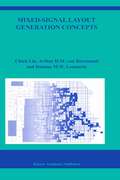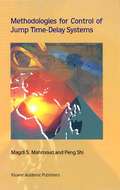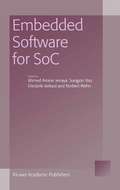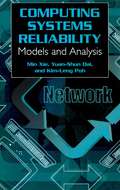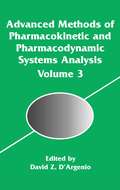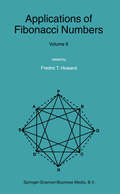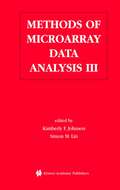- Table View
- List View
Power-Constrained Testing of VLSI Circuits: A Guide to the IEEE 1149.4 Test Standard (Frontiers in Electronic Testing #22B)
by Nicola Nicolici Bashir M. Al-HashimiThis text focuses on techniques for minimizing power dissipation during test application at logic and register-transfer levels of abstraction of the VLSI design flow. It surveys existing techniques and presents several test automation techniques for reducing power in scan-based sequential circuits and BIST data paths.
Power Estimation and Optimization Methodologies for VLIW-based Embedded Systems
by Vittorio Zaccaria M.G. Sami Donatella Sciuto Cristina SilvanoThis volume introduces innovative power estimation and optimization methodologies to support the design of low power embedded systems based on high-performance VLIW microprocessors. A VLIW processor is a (generally) pipelined processor that can execute, in each clock cycle, a set of explicitly parallel operations.
Oversampled Delta-Sigma Modulators: Analysis, Applications and Novel Topologies
by Mücahit Kozak Izzet KaleOversampled Delta-Sigma Modulators: Analysis, Applications, and Novel Topologies presents theorems and their mathematical proofs for the exact analysis of the quantization noise in delta-sigma modulators. Extensive mathematical equations are included throughout the book to analyze both single-stage and multi-stage architectures. It has been proved that appropriately set initial conditions generate tone free output, provided that the modulator order is at least three. These results are applied to the design of a Fractional-N PLL frequency synthesizer to produce spurious free RF waveforms. Furthermore, the book also presents time-interleaved topologies to increase the conversion bandwidth of delta-sigma modulators. The topologies have been generalized for any interleaving number and modulator order. The book is full of design and analysis techniques and contains sufficient detail that enables readers with little background in the subject to easily follow the material in it.
Networks on Chip
by Axel Jantsch Hannu TenhunenAs the number of processor cores and IP blocks integrated on a single chip is steadily growing, a systematic approach to design the communication infrastructure becomes necessary. Different variants of packed switched on-chip networks have been proposed by several groups during the past two years. This book summarizes the state of the art of these efforts and discusses the major issues from the physical integration to architecture to operating systems and application interfaces. It also provides a guideline and vision about the direction this field is moving to. Moreover, the book outlines the consequences of adopting design platforms based on packet switched network. The consequences may in fact be far reaching because many of the topics of distributed systems, distributed real-time systems, fault tolerant systems, parallel computer architecture, parallel programming as well as traditional system-on-chip issues will appear relevant but within the constraints of a single chip VLSI implementation.
Mixed-Signal Layout Generation Concepts (The Springer International Series in Engineering and Computer Science #751)
by Chieh Lin Arthur H.M. van Roermund Domine LeenaertsThis title covers important physical-design issues that exist in contemporary analogue and mixed-signal design flows. The authors bring together many principles and techniques required to successfully develop and implement layout generation tools to accommodate many mixed-signal layout generation needs.
Methodologies for Control of Jump Time-Delay Systems
by Magdi S. Mahmoud Peng ShiThis book is about time-domain modelling, stability, stabilization, control design and filtering for JTDS. It gives readers a thorough understanding of the basic mathematical analysis and fundamentals, offers a straightforward treatment of the different topics and provides broad coverage of the recent methodologies.
Intelligent Integrated Media Communication Techniques: COST 254 & COST 276
by Jurij F. Tasic Mohamed Najim Michael AnsorgeThis volume contains many examples and applied methods explaining the basic architecture of the mobile terminals. It includes sufficient introductory material to enabling even non-expert readers to understand the topics and to make a step towards system integration of complex future applications.
High Data Rate Transmitter Circuits: RF CMOS Design and Techniques for Design Automation (The Springer International Series in Engineering and Computer Science #747)
by C.J. de Ranter Michiel SteyaertThis practical guide and introduction to the design of key RF building blocks used in high data rate transmitters emphasizes CMOS circuit techniques applicable to oscillators and upconvertors. The book is written in an easily accessible manner, without losing detail on the technical side.
Handbook of Product and Service Development in Communication and Information Technology
by Timo O. Korhonen Antti AinamoHave you ever considered ... *How to efficiently organize and manage the multiple, parallel development projects of ICT? *How to systematically channel your team's creativity to high quality products and services? *How your company can best benefit from university research? *What are the meaning and realization of quality systems in modern ICT organizations and processes? *How to design user interfaces to maximize product usability and market value? *How to maximize the benefits of Internet in your product development and marketing? *What are the roles and important practices of patenting, and licensing in the US and Europe? This book aims to give you a top-down treatment in these and many other important topics of ICT product and service development. Our primary objective is to provide you with an eagle-eye view both in theory and in practice and to trace the state-of-the-art development. Book authors come both from universities and industry giving thus a theory and practice balancing touch for the material.
Fault Injection Techniques and Tools for Embedded Systems Reliability Evaluation (Frontiers in Electronic Testing #23)
by Alfredo Benso Paolo PrinettoThis is a comprehensive guide to fault injection techniques used to evaluate the dependability of a digital system. The description and the critical analysis of different fault injection techniques and tools are authored by key scientists in the field of system dependability and fault tolerance.
Embedded Software for SoC
by Ahmed Amine Jerraya Norbert Wehn Diederik Verkest Sungjoo Sungjoo YooThis title covers all software-related aspects of SoC design, from embedded and application-domain specific operating systems to system architecture for future SoC. It will give embedded software designers invaluable insights into the constraints imposed by the use of embedded software in an SoC context.
DSP System Design: Complexity Reduced IIR Filter Implementation for Practical Applications
by Artur Krukowski Izzet KaleThis book presents the investigation of special type of IIR polyphase filter structures combined with frequency transformation techniques, and their application for custom fixed-point implementation. Featuring a wealth of design and analysis techniques, it includes sufficient introductory material to enable non-experts to understand the topics.
Ambient Intelligence: Impact on Embedded System Design
by Twan Basten Marc Geilen Harmke De GrootHugo de Man Professor Katholieke Universiteit Leuven Senior Research Fellow IMEC The steady evolution of hardware, software and communications technology is rapidly transforming the PC- and dot.com world into the world of Ambient Intelligence (AmI). This next wave of information technology is fundam- tally different in that it makes distributed wired and wireless computing and communication disappear to the background and puts users to the foreground. AmI adapts to people instead of the other way around. It will augment our consciousness, monitor our health and security, guide us through traffic etc. In short, its ultimate goal is to improve the quality of our life by a quiet, reliable and secure interaction with our social and material environment. What makes AmI engineering so fascinating is that its design starts from studying person to world interactions that need to be implemented as an int- ligent and autonomous interplay of virtually all necessary networked electronic intelligence on the globe. This is a new and exciting dimension for most elect- cal and software engineers and may attract more creative talent to engineering than pure technology does. Development of the leading technology for AmI will only succeed if the engineering research community is prepared to join forces in order to make Mark Weiser’s dream of 1991 come true. This will not be business as usual by just doubling transistor count or clock speed in a microprocessor or increasing the bandwidth of communication.
Wireless Communications Systems and Networks (Information Technology: Transmission, Processing and Storage)
by Mohsen GuizaniSince the early 1990s, the wireless communications field has witnessed explosive growth. The wide range of applications and existing new technologies nowadays stimulated this enormous growth and encouraged wireless applications. The new wireless networks will support heterogeneous traffic, consisting of voice, video, and data (multimedia). This necessitated looking at new wireless generation technologies and enhance its capabilities. This includes new standards, new levels of Quality of Service (QoS), new sets of protocols and architectures, noise reduction, power control, performance enhancement, link and mobility management, nomadic and wireless networks security, and ad-hoc architectures. Many of these topics are covered in this textbook. The aim of this book is research and development in the area of broadband wireless communications and sensor networks. It is intended for researchers that need to learn more and do research on these topics. But, it is assumed that the reader has some background about wireless communications and networking. In addition to background in each of the chapters, an in-depth analysis is presented to help our readers gain more R&D insights in any of these areas. The book is comprised of 22 chapters, written by a group of well-known experts in their respective fields. Many of them have great industrial experience mixed with proper academic background.
Computing System Reliability: Models and Analysis
by Min Xie Kim-Leng Poh Yuan-Shun DaiComputing systems are of growing importance because of their wide use in many areas including those in safety-critical systems. This book describes the basic models and approaches to the reliability analysis of such systems. An extensive review is provided and models are categorized into different types. Some Markov models are extended to the analysis of some specific computing systems such as combined software and hardware, imperfect debugging processes, failure correlation, multi-state systems, heterogeneous subsystems, etc. One of the aims of the presentation is that based on the sound analysis and simplicity of the approaches, the use of Markov models can be better implemented in the computing system reliability.
Handbook of Biomedical Image Analysis: Volume 3: Registration Models (Topics in Biomedical Engineering. International Book Series)
by Swamy Laxminarayan David WilsonOur goal is to develop automated methods for the segmentation of thr- dimensional biomedical images. Here, we describe the segmentation of c- focal microscopy images of bee brains (20 individuals) by registration to one or several atlas images. Registration is performed by a highly parallel imp- mentation of an entropy-based nonrigid registration algorithm using B-spline transformations. We present and evaluate different methods to solve the cor- spondence problem in atlas based registration. An image can be segmented by registering it to an individual atlas, an average atlas, or multiple atlases. When registering to multiple atlases, combining the individual segmentations into a ?nalsegmentationcanbeachievedbyatlasselection,ormulticlassi?erdecision fusion. Wedescribeallthesemethodsandevaluatethesegmentationaccuracies that they achieve by performing experiments with electronic phantoms as well as by comparing their outputs to a manual gold standard. The present work is focused on the mathematical and computational t- ory behind a technique for deformable image registration termed Hyperelastic Warping, and demonstration of the technique via applications in image regist- tion and strain measurement. The approach combines well-established prin- ples of nonlinear continuum mechanics with forces derived directly from thr- dimensional image data to achieve registration. The general approach does not require the de?nition of landmarks, ?ducials, or surfaces, although it can - commodate these if available. Representative problems demonstrate the robust and ?exible nature of the approach. Three-dimensional registration methods are introduced for registering MRI volumes of the pelvis and prostate. The chapter ?rst reviews the applications, xi xii Preface challenges, and previous methods of image registration in the prostate.
Handbook of Biomedical Image Analysis: Volume 2: Segmentation Models Part B (Topics in Biomedical Engineering. International Book Series)
by David Wilson Swamy LaxminarayanHandbook of Biomedical Image Analysis: Volume 1: Segmentation Models Part A (Topics in Biomedical Engineering. International Book Series)
by David Wilson Swamy LaxminarayanHandbook of Biomedical Image Analysis: Segmentation Models (Volume I) is dedicated to the segmentation of complex shapes from the field of imaging sciences using different mathematical techniques. This volume is aimed at researchers and educators in imaging sciences, radiological imaging, clinical and diagnostic imaging, physicists covering different medical imaging modalities, as well as researchers in biomedical engineering, applied mathematics, algorithmic development, computer vision, signal processing, computer graphics and multimedia in general, both in academia and industry . Key Features: - Principles of intra-vascular ultrasound (IVUS) - Principles of positron emission tomography (PET) - Physical principles of magnetic resonance angiography (MRA). - Basic and advanced level set methods - Shape for shading method for medical image analysis - Wavelet transforms and other multi-scale analysis functions - Three dimensional deformable surfaces - Level Set application for CT lungs, brain MRI and MRA volume segmentation - Segmentation of incomplete tomographic medical data sets - Subjective level sets for missing boundaries for segmentation
Advanced Methods of Pharmacokinetic and Pharmacodynamic Systems Analysis (The Springer International Series in Engineering and Computer Science #765)
by David D'ArgenioAdvanced Methods of Pharmacokinetic and Pharmocodynamic Systems Analysis Volume 3 is vital to professionals and academicians working in drug development and bioengineering. Both basic and clinical scientists will benefit from this work.This book contains chapters by leading researchers in pharmacokinetic/pharmacodynamic modeling and will be of interest to anyone involved with the application of pharmacokinetic and pharmacodynamics to drug development. The use of mathematical modeling and associated computational methods is central to the study of the absorption, distribution and elimination of therapeutic drugs (pharmacokinetics) and to understanding how drugs produce their effects (pharmacodynamics). From its inception, the field of pharmacokinetics and pharmacodynamics has incorporated methods of mathematical modeling, simulation and computation in an effort to better understand and quantify the processes of uptake, disposition and action of therapeutic drugs. These methods for pharmacokinetic/pharmacodynamic systems analysis impact all aspects of drug development. In vitro, animal and human testing, as well as drug therapy are all influenced by these methods. Modeling methodologies developed for studying pharmacokinetic/ pharmacodynamic processes confront many challenges. This is related in part to the severe restrictions on the number and type of measurements that are available from laboratory experiments and clinical trials, as well as the variability in the experiments and the uncertainty associated with the processes themselves. The contributions are organized in three main areas: Mechanism-Based PK/PD, Pharmacometrics and Pharmacotherapy. Both professionals and academics will profit from this extensive work.
Applications of Fibonacci Numbers: Volume 9: Proceedings of The Tenth International Research Conference on Fibonacci Numbers and Their Applications
by Fredric T. HowardThis book contains 28 research articles from among the 49 papers and abstracts presented at the Tenth International Conference on Fibonacci Numbers and Their Applications. These articles have been selected after a careful review by expert referees, and they range over many areas of mathematics. The Fibonacci numbers and recurrence relations are their unifying bond. We note that the article "Fibonacci, Vern and Dan" , which follows the Introduction to this volume, is not a research paper. It is a personal reminiscence by Marjorie Bicknell-Johnson, a longtime member of the Fibonacci Association. The editor believes it will be of interest to all readers. It is anticipated that this book, like the eight predecessors, will be useful to research workers and students at all levels who are interested in the Fibonacci numbers and their applications. March 16, 2003 The Editor Fredric T. Howard Mathematics Department Wake Forest University Box 7388 Reynolda Station Winston-Salem, NC 27109 xxi THE ORGANIZING COMMITTEES LOCAL COMMITTEE INTERNATIONAL COMMITTEE Calvin Long, Chairman A. F. Horadam (Australia), Co-Chair Terry Crites A. N. Philippou (Cyprus), Co-Chair Steven Wilson A. Adelberg (U. S. A. ) C. Cooper (U. S. A. ) Jeff Rushal H. Harborth (Germany) Y. Horibe (Japan) M. Bicknell-Johnson (U. S. A. ) P. Kiss (Hungary) J. Lahr (Luxembourg) G. M. Phillips (Scotland) J. 'Thrner (New Zealand) xxiii xxiv LIST OF CONTRlBUTORS TO THE CONFERENCE * ADELBERG, ARNOLD, "Universal Bernoulli Polynomials and p-adic Congruences. " *AGRATINI, OCTAVIAN, "A Generalization of Durrmeyer-Type Polynomials. " BENJAMIN, ART, "Mathemagics.
Dynamic Reconfiguration: Architectures and Algorithms (Series in Computer Science)
by Ramachandran Vaidyanathan Jerry TrahanDynamic Reconfiguration: Architectures and Algorithms offers a comprehensive treatment of dynamically reconfigurable computer architectures and algorithms for them. The coverage is broad starting from fundamental algorithmic techniques, ranging across algorithms for a wide array of problems and applications, to simulations between models. The presentation employs a single reconfigurable model (the reconfigurable mesh) for most algorithms, to enable the reader to distill key ideas without the cumbersome details of a myriad of models. In addition to algorithms, the book discusses topics that provide a better understanding of dynamic reconfiguration such as scalability and computational power, and more recent advances such as optical models, run-time reconfiguration (on FPGA and related platforms), and implementing dynamic reconfiguration. The book, featuring many examples and a large set of exercises, is an excellent textbook or reference for a graduate course. It is also a useful reference to researchers and system developers in the area.
A Guide to Physics Problems: Part 2: Thermodynamics, Statistical Physics, and Quantum Mechanics
by Sidney B. Cahn Gerald D. Mahan Boris E. NadgornyIn order to equip hopeful graduate students with the knowledge necessary to pass the qualifying examination, the authors have assembled and solved standard and original problems from major American universities – Boston University, University of Chicago, University of Colorado at Boulder, Columbia, University of Maryland, University of Michigan, Michigan State, Michigan Tech, MIT, Princeton, Rutgers, Stanford, Stony Brook, University of Tennessee at Knoxville, and the University of Wisconsin at Madison – and Moscow Institute of Physics and Technology. A wide range of material is covered and comparisons are made between similar problems of different schools to provide the student with enough information to feel comfortable and confident at the exam. Guide to Physics Problems is published in two volumes: this book, Part 2, covers Thermodynamics, Statistical Mechanics and Quantum Mechanics; Part 1, covers Mechanics, Relativity and Electrodynamics. Praise for A Guide to Physics Problems: Part 2: Thermodynamics, Statistical Physics, and Quantum Mechanics: "… A Guide to Physics Problems, Part 2 not only serves an important function, but is a pleasure to read. By selecting problems from different universities and even different scientific cultures, the authors have effectively avoided a one-sided approach to physics. All the problems are good, some are very interesting, some positively intriguing, a few are crazy; but all of them stimulate the reader to think about physics, not merely to train you to pass an exam. I personally received considerable pleasure in working the problems, and I would guess that anyone who wants to be a professional physicist would experience similar enjoyment. … This book will be a great help to students and professors, as well as a source of pleasure and enjoyment." (From Foreword by Max Dresden) "An excellent resource for graduate students in physics and, one expects, also for their teachers." (Daniel Kleppner, Lester Wolfe Professor of Physics Emeritus, MIT) "A nice selection of problems … Thought-provoking, entertaining, and just plain fun to solve." (Giovanni Vignale, Department of Physics and Astronomy, University of Missouri at Columbia) "Interesting indeed and enjoyable. The problems are ingenious and their solutions very informative. I would certainly recommend it to all graduate students and physicists in general … Particularly useful for teachers who would like to think about problems to present in their course." (Joel Lebowitz, Rutgers University) "A very thoroughly assembled, interesting set of problems that covers the key areas of physics addressed by Ph.D. qualifying exams. … Will prove most useful to both faculty and students. Indeed, I plan to use this material as a source of examples and illustrations that will be worked into my lectures." (Douglas Mills, University of California at Irvine)
Advances in LES of Complex Flows: Proceedings of the Euromech Colloquium 412, held in Munich, Germany 4∓6 October 2000 (Fluid Mechanics and Its Applications #65)
by Rainer Friedrich Wolfgang RodiThe articles focus on new developments in the field of large-eddy simulation of complex flows and are related to the topics: modelling and analysis of subgrid scales, numerical issues in LES cartesian grids for complex geometries, curvilinear and non-structured grids for complex geometries. DES and RANS-LES coupling, aircraft wake vortices, combustion and magnetohydrodynamics. Progress has been made not only in understanding and modelling the dynamics of unresolved scales, but also in designing means that prevent the contamination of LES predictions by discretization errors. Progress is reported as well on the use of cartesian and curvilinear coordinates to compute flow in and around complex geometries and in the field of LES with unstructured grids. A chapter is dedicated to the detached-eddy simulation technique and its recent achievements and to the promising technique of coupling RANS and LES solutions in order to push the resolution-based Reynolds number limit of wall-resolving LES to higher values. Complexity due to physical mechanisms links the last two chapters. It is shown that LES constitutes the tool to analyse the physics of aircraft wake vortices during landing and takeoff. Its thorough understanding is a prerequisite for reliable predictions of the distance between consecutive landing airplanes. Subgrid combustion modelling for LES of single and two-phase reacting flows is demonstrated to have the potential to deal with finite-rate kinetics in high Reynolds number flows of full-scale gas turbine engines. Fluctuating magnetic fields are more reliably predicted by LES when tensor-diffusivity rather than gradient-diffusion models are used. An encouraging result in the context of turbulence control by magnetic fields.
Methods of Microarray Data Analysis III: Papers from CAMDA ‘02
by Simon M. Lin Kimberly F. JohnsonAs microarray technology has matured, data analysis methods have advanced as well. Methods Of Microarray Data Analysis III is the third book in this pioneering series dedicated to the existing new field of microarrays. While initial techniques focused on classification exercises (volume I of this series), and later on pattern extraction (volume II of this series), this volume focuses on data quality issues. Problems such as background noise determination, analysis of variance, and errors in data handling are highlighted. Three tutorial papers are presented to assist with a basic understanding of underlying principles in microarray data analysis, and twelve new papers are highlighted analyzing the same CAMDA'02 datasets: the Project Normal data set or the Affymetrix Latin Square data set. A comparative study of these analytical methodologies brings to light problems, solutions and new ideas. This book is an excellent reference for academic and industrial researchers who want to keep abreast of the state of art of microarray data analysis.
The Complete Handbook of the Internet
by B. BuchananThe Complete Handbook of the Internet covers all of the recent developments and relevant areas in the Internet Technology. This two volume handbook is divided into ten different sections.The Complete Handbook of the Internet is a complete and essential reference for academics and professionals whom are developing and working with the Internet.




